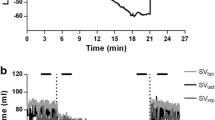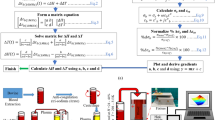Abstract
The accuracy of impedance cardiography for measurement of stroke volume (SV2) has been controversial. This could be, in part, due to the use in the Kubicek formula of the bench-determined blood resistivity (ϱ)-haematocrit (Hct) relationship, which does not take into account factors such as complex blood-velocity movements. In the present studyin vivo, ϱ was calculated in dog, rabbit and man from the rearranged Kubicek formula, ϱ=(SV. Zo2)/(L2. dZ/dt max T); the stroke volumes used in the calculation being derived at different Hcts in the different species from the independent techniques of electromagnetic flowmeter, direct Fick, and direct Fick and thermodilution, respectively. Thein vivo ϱ-Hct relationship is linear, inverse and nearly constant over the range of Hcts tested (dog 26–62%, man 31–48%, rabbit 37%). No significant difference exists between meanin vivo ϱ values determined for the three species at corresponding haematocrits despite different thoracic anatomy and circulatory dynamics. Thus, the best estimate of mean ϱin vivo within the normal Hct range is 135Ω cm, the use of which will result in a SV2 accuracy of better than ±10%.
Similar content being viewed by others
References
Baker, L. E., Judy, W. V., Geddes, L. A., Langley, F. M. andHill, D. W. (1971) The measurement of cardiac output by means of electrical impedance.Cardiovasc. Res. Center Bull.,9, 135–145.
Denniston, J. C., Maher, J. T., Reeves, J. T., Cruz, J. C., Cymerman, A. andGrover, R. F. (1976) Measurement of cardiac output by electrical impedance at rest and during exercise.J. Appl. Physiol. 40, 91–95.
Frewer, R. A. (1974) The electrical conductivity of flowing blood.Biomed. Eng.,9, 552–555.
Geddes, L. A. andBaker, L. E. (1967) The specific resistance of biological material—a compendium of data for the biomedical engineer and physiologist.Med. & Biol. Eng.,5, 271–293.
Geddes, L. A. andSadler, C. (1973) The specific resistance of blood at body temperature.Med. & Biol. Eng.,11, 336–339.
Hill, D. W. andThompson, F. D. (1975a) The effect of haematocrit on the resistivity of human blood at 37°C and 100 KHz.Med. & Biol. Eng.,13, 182–186.
Hill, D. W. andThompson, F. D. (1975b) The importance of blood resistivity in the measurement of cardiac output by the thoracic impedance method.Med. & Biol. Eng.,13, 187–191.
Kelman, G. R. andNunn, J. F. (1966) Nomograms for correction of bloodpO2,pCO2, pH and base excess for time and temperature.J. Appl. Physiol.,21, 1484–1490.
Kubicek, W. G., Karnegis, J. N., Patterson, R. P., Witsoe, D. A. andMattson, R. H. (1966) Development and evaluation of an impedance cardiac output system.Aerospace Med.,37, 1208–1212.
Kubicek, W. G., From, A. H. L., Patterson, R. P., Witsoe, D. A., Castaneda, A., Lillehei, R. C. andErsek, R. (1970) Impedance cardiography as a noninvasive means to monitor cardiac function.J. Assoc. Advanc. Med. Instrument,4, 79–84.
Liebman, J. P., Pearl, J. andBagno, S. (1962) The electrical conductance properties of blood in motion.Physics Med. Biol.,7, 177–194.
Mohapatra, S. N., Costeloe, K. L. andHill, D. W. (1977) Blood resistivity and its implications for the calculation of cardiac output by the thoracic electrical impedance technique.Intens. Care Med.,3, 63–67.
Pate, T. D., Baker, L. E. andRosborough, J. P. (1975) The simultaneous comparison of the electrical impedance method for measuring stroke volume and cardiac output with four other methods.Cardiovasc. Res. Bull.,14, 39–52.
Patterson, R. P. (1965) Cardiac output determinations using impedance, plethysmography.M.S.E.E. thesis, University of Minnesota.
Sokal, R. R. andRohlf, R. J. (1969)Biometry, San Francisco, W. H. Freeman, 405–468.
Visser, K. R., Lamberts, R., Korstein, H. H. M. andZijlstra, W. G. (1976) Observations on blood flow related electrical impedance changes in rigid tubes.Pflugers Arch.,366, 289–291.
Author information
Authors and Affiliations
Rights and permissions
About this article
Cite this article
Traugott, F.M., Quail, A.W. & White, S.W. Evaluation of blood resistivityin vivo for impedance cardiography in man, dog and rabbit. Med. Biol. Eng. Comput. 19, 547–552 (1981). https://doi.org/10.1007/BF02442767
Received:
Accepted:
Issue Date:
DOI: https://doi.org/10.1007/BF02442767




